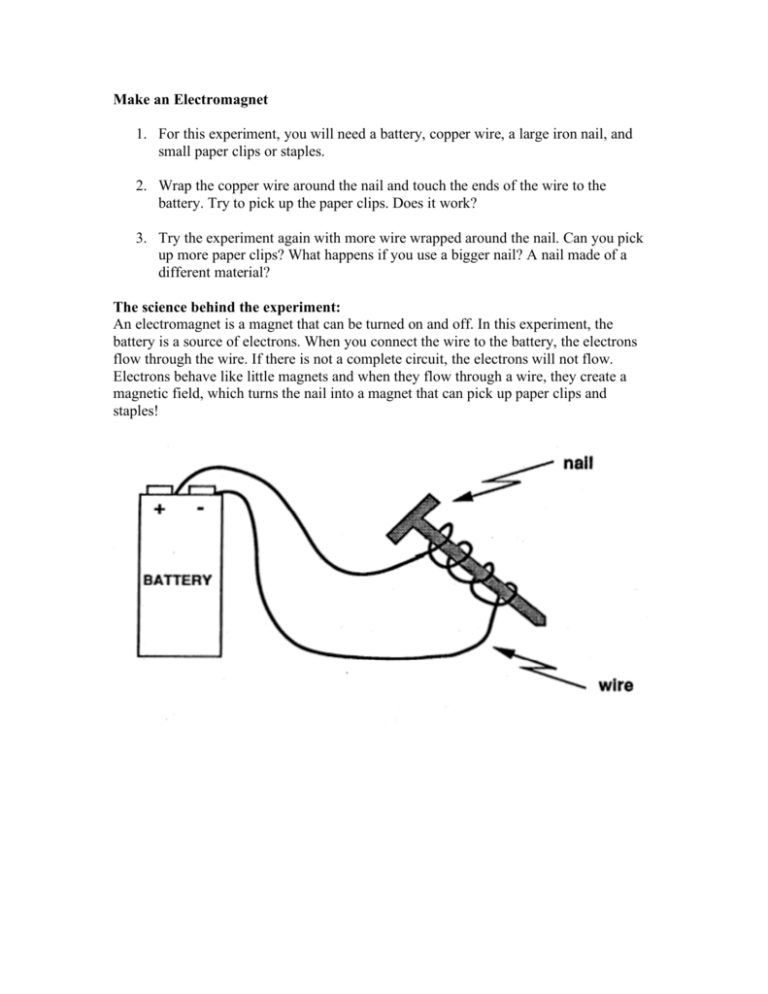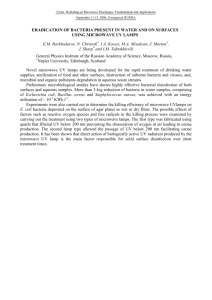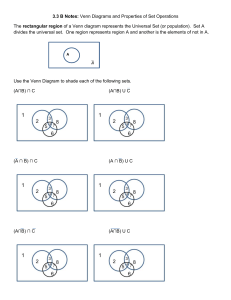Make an Electromagnet 1. For this experiment, you will need a
advertisement

Make an Electromagnet 1. For this experiment, you will need a battery, copper wire, a large iron nail, and small paper clips or staples. 2. Wrap the copper wire around the nail and touch the ends of the wire to the battery. Try to pick up the paper clips. Does it work? 3. Try the experiment again with more wire wrapped around the nail. Can you pick up more paper clips? What happens if you use a bigger nail? A nail made of a different material? The science behind the experiment: An electromagnet is a magnet that can be turned on and off. In this experiment, the battery is a source of electrons. When you connect the wire to the battery, the electrons flow through the wire. If there is not a complete circuit, the electrons will not flow. Electrons behave like little magnets and when they flow through a wire, they create a magnetic field, which turns the nail into a magnet that can pick up paper clips and staples! Make a Miniature Roller Coaster You can make a roller coaster using foam tubes that are often used for pipe insulation. Cut the foam tubing in half and you have a track for a marble to roll down. The foaming can be taped on the wall (using masking tape) and moved around to make a roller coaster. Try this: 1. Change the height of the first hill. How does that change the speed of the marble at the bottom? 2. Try to make a loop. What do you have to do so the marble makes the loop? 3. Try to launch the marble off the end into a cup. 4. Get creative! What else can you make your roller coaster do? The science behind the experiment: Roller coasters work on the principle of energy conservation. At the top of the first hill, the marble has potential energy meaning it has the potential to move if you let go of it. When you let go of the marble its potential energy is converted into kinetic energy, the energy of motion. The loop is tricky; it takes extra energy for the marble to stay on the track, so it has to slow down when it goes through the loop. When the marble finally gets to the floor, it has all kinetic energy and no potential energy. The total amount of energy in the system is always the same. Spin like an Ice Skater For this experiment, you need a spinning chair, like an office chair. Sit on the chair with your arms stretched out to the sides. Have someone spin you around and then bring your arms in. What happens? Try it again with extra weight in your hands. You can use small hand weights or cans of soup. The science behind the experiment: The spinning ice skater is a demonstration of conservation of angular momentum. What do all those big words mean? Conservation means that it is always the same. Angular means you are spinning and momentum is a combination of your speed and your inertia (how hard it is to move you). With your arms out, it’s harder to move you, so you go slower. With arms in, it is easier to move you and so you go faster. Static Electricity Experiments 1. Rub your hair on a balloon or wool sweater. What happens to your hair? Try to stick the balloon to the wall. Does it stick? 2. Rub a plastic pen on the wool sweater and hold it near a stream of water. What do you observe? 3. Rub the pen on the sweater again and try to pick up small pieces of paper. The holes from a hole punch work well. The science behind the experiments: In all of these experiments, we are manually moving electrons from one material to another. Your hair stands up because it is full of electrons. The electrons don’t like each other and are trying to get as far away from each other as possible. The balloon sticks to the wall because it creates an induced charge. The positive charge of the balloon attracts electrons from the wall and the balloon sticks! The same thing happens with the pen and the water and the pen and the paper. - + + + + + + + + + + + - + ++ + - + + + + Balloon - Wall - Making a Pinhole Camera Materials • Box (square or round – a Pringles can or oatmeal container work well) • Wax Paper • Nail or thumbtack to make a hole • Aluminum foil • Sharp Knife or scissors • Tape • Bright light source (the sun works well!) Procedure 1. Draw a line around the box about 2 inches from the bottom. Have a grown up cut the box in two pieces. 2. Use the nail or thumbtack to make a hole in the bottom of the small end of the box. 3. Cover the open end of that box with wax paper and tape on the outside. (If you used a box with a plastic lid, you may use that instead of the wax paper. 4. Cut an eye hole in the top of the box. 5. Put the two boxes back together and tape them together. 6. Cover the whole thing with foil to make sure that no light can enter. 7. Hold your hand below the box and slowly move it upward. If you look in the hole, you’ll see the shadow move down1 8. Go out side on a sunny day and you’ll be able to see an image upside down on your screen. Close the eye that’s not looking in the box. You want it to be as dark as possible, so you may want to cup your hand around your “looking eye”. What’s going on? The pinhole acts like a lens and diffracts light as it passes through. We can see the image because light reflects off of everything. Only a small amount of reflected light traveling in a particular direction can go through the hole and that’s what we see on the screen. This was originally called a camera obscura. Measuring the Speed of Light Materials You Need • Microwave • Microwave safe dish at least 5-6 inches across (bigger is better) • Mini-marshmallows • Ruler • Calculator Procedure 1. Place the mini-marshmallows in the dish one layer thick. 2. If your microwave has a rotating platform, remove it. We don’t want the dish to rotate. 3. Put the dish in the microwave for 10 seconds. 4. When you remove the dish, you’ll notice only certain parts are melted. (Time may depend on microwave – if all or none of your marshmallows melted, adjust the time.) 5. Measure the distance between melted marshmallows using your ruler. Measure in centimeters. This is half the wavelength of a microwave. 6. Look for a sticker on your microwave that tells you its frequency in Hertz (Hz). Note: MHz = 106 Hz 7. Use the following equation to find the speed of light: Speed of light = 2*(distance between melted spots)*(frequency of microwave) 8. The actual speed of light is 3.00 x 1010 cm/s. How close were you? What’s going on? Microwaves are a form of electromagnetic radiation, just like light, but they are beyond the visible spectrum so we cannot see them. A microwave oven works by creating a standing wave in the microwave. The peaks of the wave heat faster and melt the marshmallows first. What you measure is half the wavelength of the microwave light. The arrow shows one full wavelength of microwave light.




